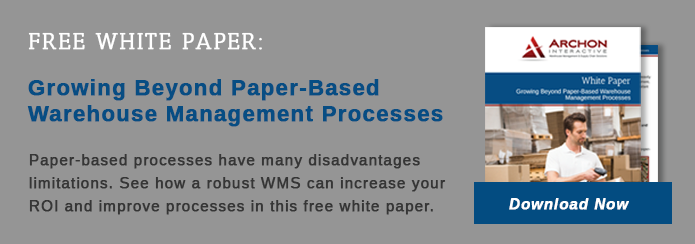 It is easy to see how paper-based warehouse management can be a slow and arduous process, but it may be harder to recognize some of the hidden costs associated with paper-based systems. While you are focused on direct costs, you could be missing the pennies and nickels that paper is costing you each and every day.
It is easy to see how paper-based warehouse management can be a slow and arduous process, but it may be harder to recognize some of the hidden costs associated with paper-based systems. While you are focused on direct costs, you could be missing the pennies and nickels that paper is costing you each and every day.
Small Scale Versus Large Scale
When it comes to figuring out your day-to-day operating expenses and finding ways to cut costs, it is more than likely that you are looking at only big-picture expenses. Overall labor costs and monthly bills are the areas where most businesses strive to save money. Unfortunately, without a Warehouse Management System (WMS), it is extremely difficult to take analyze what makes up those expenses.
A WMS can help you tighten up your labor by identifying operational inefficiencies, unnecessary downtime, and underperforming team members. By isolating and clearly identifying where problems occur, you can take steps to fix them and increase your warehouse efficiency.
Redundant Work
Paper-based warehouse management systems can't compete with their computerized counterparts when it comes to resolving problems. A modern WMS contains multiple verification processes to ensure accuracy. The fewer problems your staff encounters and the fewer complaint your customers report, the higher your warehouse efficiency will be. You will not have to waste time digging through piles of paperwork to identify errors because the WMS will provide you with a clear history of what happened and when and who was involved.
Every time you have to resolve an issue, you are losing money. Paper-based systems do not provide adequate protection against these errors in real time.
Materials Costs
Another area where you might be losing money is in the cost of paper materials. It may seem minor to say that you only buy a few extra boxes of paper here and there, but ink and toner cartridges can cost up to $300 each, and you are blazing through them every month. What would your office supply budget look like if you converted to a paperless system and no longer relied on physical copies of your inventory? Could you end up saving a few hundred dollars a quarter or even a month?
The problem with paper-based warehouse management systems is that they allow you to think you are saving money on the front end while stealing money out of your pocket on the back end. Unfortunately, it usually comes in the form of a few dollars here and there, so you may not grasp the full scale of those expenses until it is too late. Warehouse Management Systems overcome this by zooming in on inefficiencies and eliminating them altogether. A new WMS will also cut out many of the supply costs that come with producing paper records. As you acclimate to the WMS, you will begin to see large increases in your warehouse efficiency, and these increases will give you higher profit margins as well.




